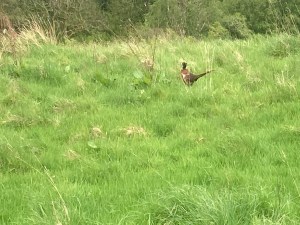Walking to Cape Wrath, Day 13, May 23, 2022
A typical day hiking New Zealand’s Te Araroa on the South Island is rising in the morning to hike alongside a river, heading upstream so the path continually rises as the river diminishes. Usually by around noon, the trail crosses a saddle, and you can look back at the watershed you have just traversed, and then look out over a new valley, so the afternoon is spent walking down by a growing river. Although not quite as dramatic, much of today followed that pattern (in miniature).
I left Comrie fairly early (before any of the coffee shops opened—thankfully my inn had packed me a breakfast bag). The path followed the fast flowing Lednock river, leading up to the Devil’s Cauldron waterfall. Then after some more climbing, some wet pasture traversing, I followed the trail over the pass near Ben Chronzie, moving midday into the watershed of the River Almond. It was very much a day of isolation as I only saw one other hiker (who had just climbed Ben Chronzie) and one farmer on a quad bike with two border collies on back. The day alternated between well-benched farm tracks and very faint paths that were often just streams. And of course it rained a lot, off and on, across the day. The bog walking was, as yesterday, a slog, but I was reminded of a wonderful part of a Robert Macfarlane book. I wrote a little bit about it here: https://walkinghome.lmc.gatech.edu/pointless-essays/wonderlust/ But the gist is here: “In the last chapter of Landmarks, a book on disappearing place-names, Robert MacFarlane describes the activities of children exploring their version of the Hundred Acre Wood. He examines the language they invent to mark out their daily wonders. One child became obsessed with watercourses, speculating that much of it disappeared by flowing beneath the ground, a phenomenon he called “secret water.” Since reading that chapter, I’ve have found myself in many boggy places on the Te Araroa hearing a deep gurgle and saying (usually out loud, as I have no social censor in the bush) secret water!”
Then late in the day, the New Zealand pattern repeated. I left the River Almond watershed to go up a narrow glen to a pass that led me down through even more bogs into the Loch Freichie area. Up on the ridge was amazing as the new watershed didn’t just open. Instead there were several hollows where water clearly collected but had no obvious outlet to join either burn— the one I had just hiked up, or the one I was slogging my way down. In other words, there was a lot of water in that pass. Wildlife abounded, with a moment where I saw the silhouette of a deer on the ridge above me (reminded me a o scene with Robert DeNiro in The Deerhunter). It hesitated briefly then ran down the other side. Soon after, a momma quail pulled the broken-wing walk on the path in front of me, leading me away from her brood who were squawking on the bank. After about ten yards, she turned and grunted at me (as much to say, “fooled you!”), returning to her nestlings.
The Scottish National Trail guide notes that there are no accommodations (including) transportation at Loch Freichie and recommend wild camping. I looked hard for a site as the path lead to the lake, but with all the rain (and all that secret water) there were few likely places to pitch. I turned onto the paved road which had a number of houses and farms on it, still looking in vain for a site. Then I happened onto a small walled-in field with no livestock and a shed behind which I could tent. Was a long tiring day, but glad to find a spot before the evening rains returned. Tomorrow Aberfeldy!
T. Hugh Crawford





































